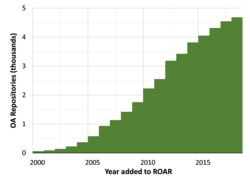Organization:Registry of Open Access Repositories
Registry of Open Access Repositories | |
 ROAR Growth of open access repositories, 2000-2018 | |
| Formation | 2003 |
|---|---|
| Website | http://roar.eprints.org |
The Registry of Open Access Repositories (ROAR) is a searchable international database indexing the creation, location and growth of open access institutional repositories and their contents. ROAR was created by EPrints at University of Southampton, UK, in 2003.[1][2][3][4] It began as the Institutional Archives Registry and was renamed Registry of Open Access Repositories in 2006.[5][6] To date, over 3,000 institutional and cross-institutional repositories have been registered.[7]
As of 2015, ROAR and the UK-based Directory of Open Access Repositories (OpenDOAR) "are considered the two leading open access directories worldwide. ROAR is the larger directory and allows direct submissions to the directory. OpenDOAR controls submission of materials and is dependent on the discretion of its staff. OpenDOAR requires open access of scholarly publications; whereas ROAR allows other types of materials to be included. ROAR allows filtering by country, type of repository, and sorting by repository name."[8]
ROARMAP
ROAR's companion Registry of Open Access Repository Mandates and Policies (ROARMAP) is a searchable international database of policies. It charts the growth of open access mandates and policies adopted by universities, research institutions and research funders that require their researchers to provide open access to their peer-reviewed research article output by depositing it in an open access repository.
It was created by EPrints at University of Southampton in 2003.[9][10][11][12][13] The Institutional Self-Archiving Policy Registry became the Registry of Open Access Repository Material Archiving Policies in 2006, then the Registry of Open Access Repositories Mandatory Archiving Policies, and then the Registry of Open Access Repository Mandates and Policies around 2014.[6][14]
ROARMAP mandates are classified in terms of strength and effectiveness[15] in MELIBEA[16] As of October 2015, open-access mandates have been adopted by more than 520 universities and more than 75 research funders worldwide.[17]
References
- ↑ Brody, T, Carr, L, Hey, JMN, Brown, A, Hitchcock, S (2007) PRONOM-ROAR: Adding Format Profiles to a Repository Registry to Inform Preservation Services. The International Journal of Digital Curation 2(2)
- ↑ McDowell, CS (2007) Evaluating Institutional Repository Deployment in American Academe Since Early 2005: Repositories by the Numbers D-Lib 13 (9/10)
- ↑ Xia, J. (2011). "An anthropological emic-etic perspective on open access practices". Journal of Documentation 67 (1): 75–94. doi:10.1108/00220411111105461.
- ↑ Krishnamurthy, M.; Kemparaju, T. D. (2011). "Institutional repositories in Indian universities and research institutes". Program: Electronic Library & Information Systems 45 (2): 185–198. doi:10.1108/00330331111129723.
- ↑ Tim Brody, ed. "Archives.eprints.org". http://archives.eprints.org. "The Institutional Archive Registry tracks the number and size of open-access eprint archives"
- ↑ Jump up to: 6.0 6.1 "Open Access News". 22 February 2006. http://legacy.earlham.edu/~peters/fos/2006/02/two-eprints-services-renamed.html.
- ↑ "Browse by Repository Type". http://roar.eprints.org/view/type/.
- ↑ Patricia H. Dawson; Sharon Q. Yang (2016). "Institutional Repositories, Open Access and Copyright: What Are the Practices and Implications?". Science & Technology Libraries 35 (4): 279–294. doi:10.1080/0194262X.2016.1224994. http://eprints.rclis.org/32654/1/IRpaper_postprint_pdf.pdf.
- ↑ Moskovkin, VM (2008) Institutional policies for open access to the results of scientific research . Scientific and Technical Information Processing. 35 (6) 269–273, doi:10.3103/S0147688208060075
- ↑ Sale, AHJ (2007) The patchwork mandate . D-Lib Magazine, 13 (1/2). ISSN 1082-9873
- ↑ Manikandan, S; N Isai Vani (2010) "Restricting access to publications from funded research: Ethical issues and solutions." Journal of Postgraduate Medicine 56(2): 154–156
- ↑ Lyons, Charles; H Austin Booth (2010) "An Overview of Open Access in the Fields of Business and Management". Journal of Business & Finance Librarianship 16(2): 1080124 doi:10.1080/08963568.2011.554786
- ↑ Hurrell, A. C. (2012) Open access policies on scholarly publishing in the university context. BCLA Browser: Linking the Library Landscape, 4(3).
- ↑ "Roarmap.eprints.org". http://roarmap.eprints.org.
- ↑ Gargouri, Y., Lariviere, V., Gingras, Y., Brody, T., Carr, L., & Harnad, S. (2012). Testing the Finch Hypothesis on Green OA Mandate Ineffectiveness. arXiv preprint arXiv:1210.8174.
- ↑ "MELIBEA directory and estimator of institutional open-access policies". http://www.accesoabierto.net/politicas/default.php.
- ↑ "Browse by Policymaker Type". http://roarmap.eprints.org/view/policymaker_type/.
External links
Wikidata has the property:
|
 |

